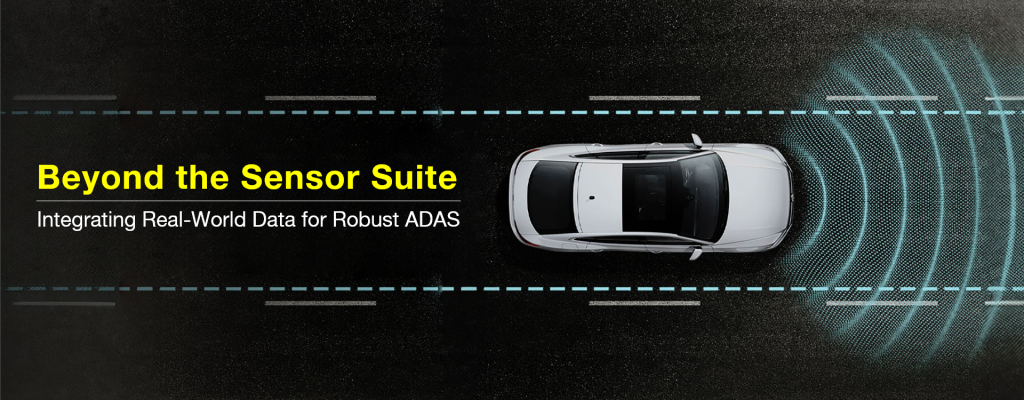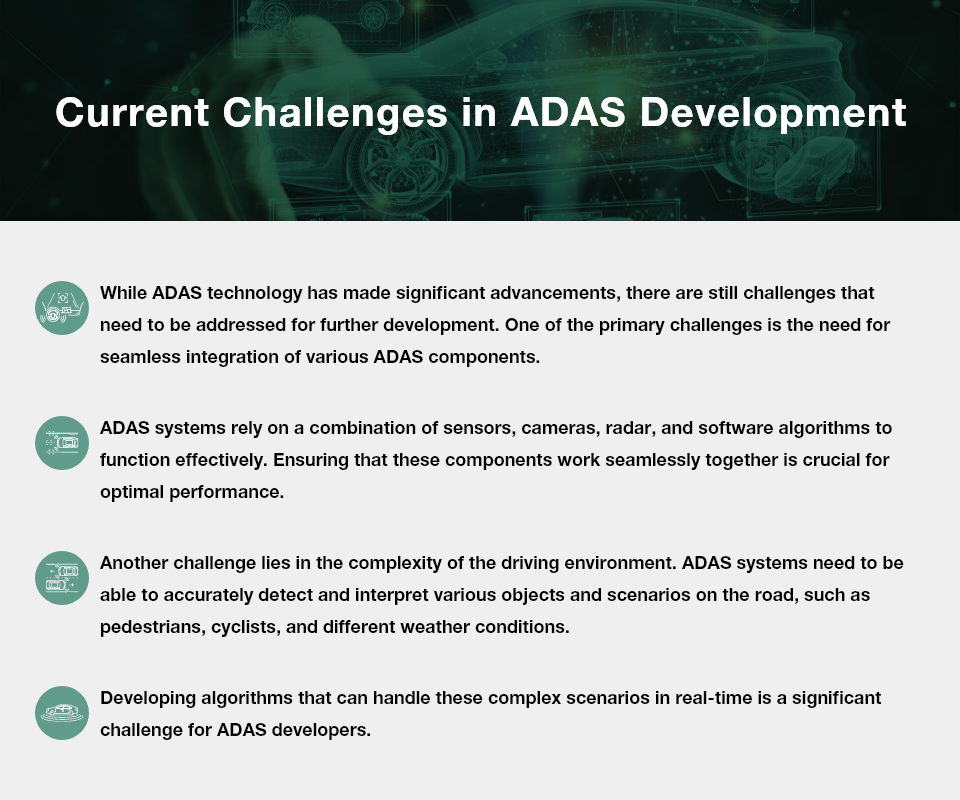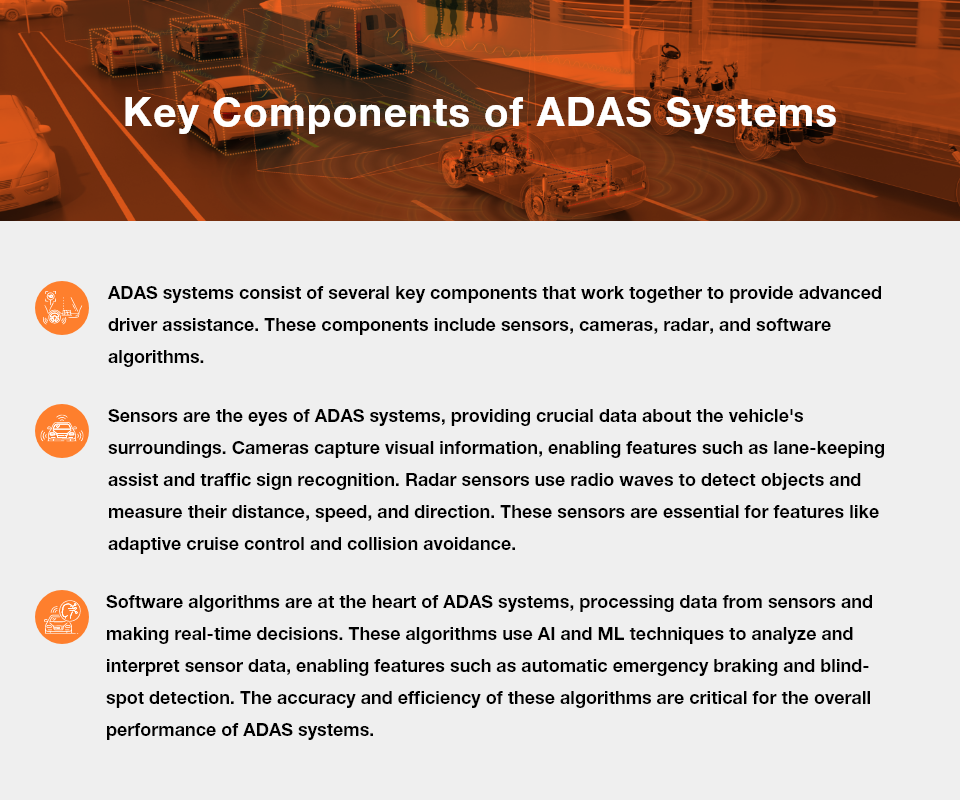
Posted On Jun 06 2024 | 12:35
Advanced Driver Assistance Systems (ADAS) play a crucial role in the development of smart mobility. These systems leverage cutting-edge technologies such as artificial intelligence (AI), machine learning (ML), and sensor technologies to assist drivers in avoiding accidents, improving road safety, and enhancing overall driving experience. ADAS features range from adaptive cruise control to lane-keeping assist, and they are becoming increasingly advanced and sophisticated.
ADAS not only provides convenience to drivers but also helps to reduce accidents and fatalities on the road. According to a report by the National Highway Traffic Safety Administration (NHTSA), ADAS features have the potential to prevent up to 94% of all fatal crashes caused by human error. This statistic highlights the importance of ADAS in creating a safer driving environment.

Furthermore, ensuring the cybersecurity of ADAS systems is of utmost importance. As vehicles become more connected and rely on data exchange, the risk of cyber threats increases. Developing robust security measures to protect ADAS systems from cyber-attacks is essential to maintain the integrity and safety of smart mobility.
Know more how at People Tech Group, we address these challenges.
The future of smart mobility is being shaped by a range of emerging technologies that are revolutionizing the way we drive. One such technology is V2X communication, which stands for Vehicle-to-Everything communication. V2X enables vehicles to communicate with each other, as well as with infrastructure and pedestrians. This technology allows for real-time exchange of information, enhancing safety and efficiency on the road.
LiDAR (Light Detection and Ranging) uses laser light to measure distances and create detailed 3D maps of the surrounding environment. LiDAR technology is essential for autonomous driving as it provides accurate and real-time data about the vehicle’s surroundings. By incorporating LiDAR into ADAS systems, we can further enhance their capabilities and enable more advanced features.
Additionally, edge computing is playing a crucial role in smart mobility. Edge computing involves processing data at the edge of the network, closer to where it is generated. This enables faster and more efficient data analysis, leading to real-time decision-making. By leveraging edge computing, ADAS systems can react quickly to changing road conditions, ensuring a safer driving experience.

Machine learning and artificial intelligence are revolutionizing ADAS development by enabling systems to learn and improve over time. ML algorithms can analyze vast amounts of data collected from sensors and learn patterns and behaviors. This allows ADAS systems to adapt to different driving conditions and provide more accurate and reliable assistance to drivers.
One area where ML is particularly beneficial is in object detection and recognition. ML algorithms can be trained to identify and classify various objects on the road, such as pedestrians, vehicles, and road signs. By continuously learning from real-world data, ADAS systems can improve their object detection capabilities, reducing the risk of accidents and improving overall road safety.
Another application of AI in ADAS development is in predictive modeling. AI algorithms can analyze historical data to predict potential hazards and dangerous situations on the road. By alerting drivers in advance, ADAS systems can help prevent accidents and provide proactive assistance.
Furthermore, AI can be used to optimize the performance of ADAS systems by analyzing data in real-time. By continuously monitoring sensor data and driver behavior, AI algorithms can make instant adjustments to improve the accuracy and responsiveness of ADAS features.
Data analytics plays a crucial role in optimizing the performance of ADAS systems. By analyzing vast amounts of data collected from sensors, ADAS developers can gain valuable insights into driving patterns, road conditions, and potential risks.
One application of data analytics is in detecting anomalies and identifying potential system failures. By monitoring sensor data in real-time, ADAS systems can detect any abnormalities or malfunctions and alert drivers or initiate a fail-safe mechanism. This proactive approach ensures the reliability and safety of ADAS systems.
Data analytics can also be used to identify areas for improvement in ADAS performance. By analyzing driver behavior data, such as braking patterns and steering inputs, ADAS developers can identify areas where the system can provide more precise and smoother assistance. This iterative approach allows for continuous improvement and refinement of ADAS features.
Furthermore, data analytics can help ADAS developers fine-tune algorithms and parameters for optimal performance. By analyzing the impact of different settings on system behavior, developers can optimize the trade-off between performance and safety. This data-driven approach ensures that ADAS systems provide the best possible assistance to drivers while maintaining high levels of safety.
The future of ADAS development holds exciting possibilities and advancements. One of the key trends is the integration of ADAS with cloud computing. By leveraging cloud resources, ADAS systems can access vast amounts of data and computing power, enabling more advanced features and faster decision-making. Cloud integration also allows for remote updates and improvements to ADAS systems, ensuring that they are always up to date with the latest technology.
Another trend is the development of cooperative ADAS systems. These systems enable vehicles to communicate with each other, sharing information about road conditions, traffic, and potential hazards. By collaborating, vehicles can optimize their driving strategies and enhance overall road safety. Cooperative ADAS can also pave the way for autonomous driving, as vehicles can synchronize their movements and make collective decisions.
Furthermore, the future of ADAS development will see advancements in sensor technologies, which are expected to become more compact, affordable, and accurate, making it more accessible for mass market adoption. Improved sensor technologies will enable ADAS systems to provide even more precise and detailed information about the surrounding environment, enhancing their capabilities and performance.
The future of smart mobility holds immense potential for enhancing transportation and improving road safety. ADAS development plays a critical role in realizing this future by incorporating advanced technologies such as AI, ML, and sensor technologies into vehicles. By continuously enhancing ADAS capabilities, we can create a seamless and secure driving experience for all.
As we look ahead, it is essential to address the challenges in ADAS development and embrace emerging technologies. Seamless integration of components, robust cybersecurity measures, and the ability to handle complex driving scenarios are crucial for the success of ADAS systems. By leveraging machine learning, artificial intelligence, and data analytics, we can optimize the performance of ADAS systems and unlock their untapped potential.
Regulatory bodies and governments must also play their part by establishing guidelines and standards that ensure the safe and responsible use of ADAS technology. By promoting driver awareness and providing proper training, we can maximize the benefits of ADAS while minimizing potential risks.
The future of smart mobility is within our reach. It is up to us to embrace the possibilities, unlock the secrets, and shape a future where driving becomes a seamless and secure experience for all. Buckle up and get ready for the thrilling ride into the future of transportation. Talk to our experts to integrate the future of smart mobility starts now
